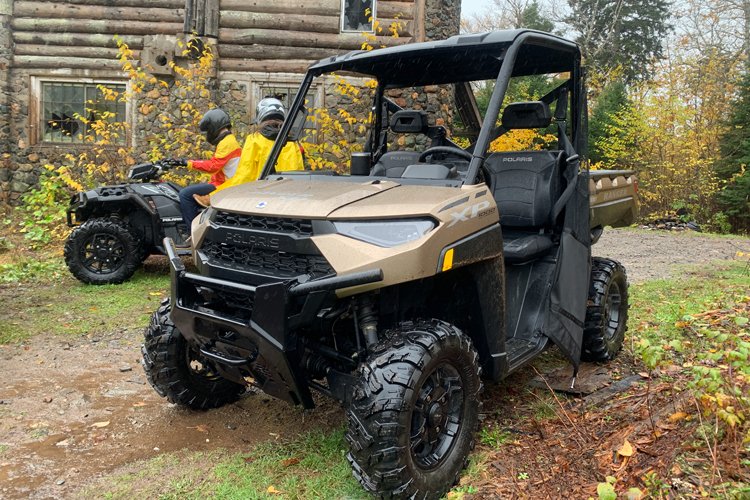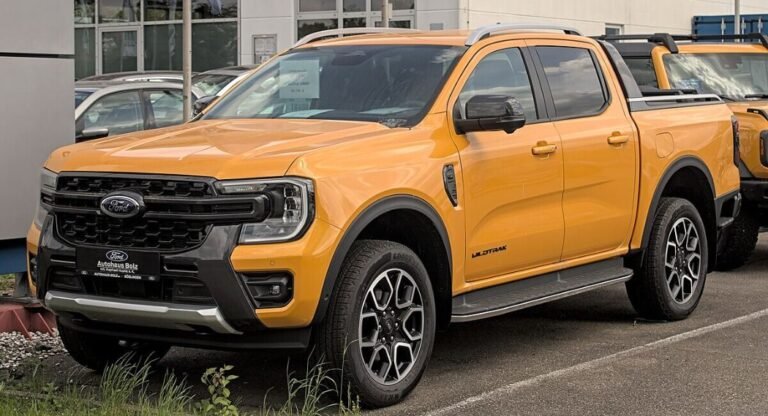How to Drive a Polaris Ranger: Expert Tips & Tricks
To drive a Polaris Ranger, sit in the driver’s seat, put on the seatbelt, and turn the ignition key to start the engine. Then, press the brake pedal and shift the gear into the desired mode.
Polaris Ranger is a versatile off-road vehicle that can be used for work or play. Whether you’re exploring the backcountry or doing some yard work, driving a Polaris Ranger can be a fun and exciting experience. However, before you hit the road, it’s important to know the basics of driving the vehicle.
We’ll go over some tips on how to drive a Polaris Ranger safely and efficiently. We’ll cover everything from starting the engine to shifting gears, turning, and braking. So buckle up and get ready to learn how to drive a Polaris Ranger like a pro!
Introduction To Polaris Ranger

The Polaris Ranger is a versatile and robust off-road vehicle that provides the thrill of adventure and the functionality of a workhorse. Whether you are exploring the great outdoors or tackling tough jobs on the farm, the Polaris Ranger is designed to deliver exceptional performance and reliability. In this article, we will take a closer look at the Polaris Ranger, its popularity in off-roading, and its impressive specifications.
Popularity In Off-roading
The Polaris Ranger has gained immense popularity in the off-roading community due to its exceptional off-road capabilities, durability, and versatility. From trail riding to rock crawling, the Polaris Ranger is renowned for its ability to conquer diverse terrains with ease. Its robust construction and advanced suspension system make it a top choice for off-road enthusiasts seeking adventure and excitement.
Vehicle Specifications
Pre-drive Checklist
Before driving a Polaris Ranger, it’s crucial to go through a pre-drive checklist. Check the fuel, brakes, tire pressure, and lights. Ensure that the seat belts and safety harnesses are properly fastened, and always inspect the vehicle for any potential issues before hitting the road.
Safety Gear Essentials
- Helmet with face shield
- Protective gloves
- Long-sleeve shirt and pants
- Sturdy boots
Vehicle Inspection Points
- Check tire pressure
- Inspect brakes for responsiveness
- Ensure lights are working
- Verify fuel level
Before embarking on your Polaris Ranger adventure, it’s crucial to go through a thorough pre-drive checklist to ensure a safe and enjoyable ride.
When it comes to safety gear essentials, make sure to equip yourself with a helmet featuring a face shield, protective gloves, long-sleeve shirt and pants, as well as sturdy boots.
Now, let’s shift our focus to the vehicle inspection points. Start by checking the tire pressure to ensure optimal performance on various terrains. Next, inspect the brakes to guarantee they are responsive and in good working condition.
Moreover, take a moment to ensure all lights on the Polaris Ranger are functioning properly, enhancing visibility during your ride. Finally, don’t forget to verify the fuel level to avoid unexpected stops along the way.
Getting Comfortable With The Controls
To drive a Polaris Ranger, it’s essential to get comfortable with the controls. Familiarize yourself with the gear shift, brakes, accelerator, and steering wheel before hitting the road. Take your time and practice in an open area before venturing out on more challenging terrain.
Dashboard Layout
The Polaris Ranger is a powerful machine that comes with a dashboard filled with various controls. Before you start driving, familiarize yourself with the dashboard layout. On the left side, you will see the light switch, while on the right side, you will see the ignition switch. The dashboard also includes a speedometer, fuel gauge, and a variety of warning lights. Take some time to understand each of these controls and what they do.
Understanding The Gear System
Once you are comfortable with the dashboard, it’s time to move on to the gear system. The Polaris Ranger typically comes with a gear shift lever that is located between the driver and passenger seats. Make sure you understand the different gears and what they are used for. In general, the lower gears are used for slow speeds and off-road driving, while the higher gears are used for faster speeds on smoother terrain.
Before you start driving, it’s important to get comfortable with all of the controls. Adjust the seats, mirrors, and steering wheel to ensure that you have a clear view of the road ahead. Make sure you know how to use the brakes, accelerator, and gear shift. Practice using these controls in a safe and controlled environment before you hit the road. Remember, safety should always be your top priority.
In conclusion, familiarizing yourself with the dashboard layout and gear system is crucial when learning how to drive a Polaris Ranger. Practice using all of the controls in a safe and controlled environment before you hit the road. With a little practice, you’ll be driving your Polaris Ranger like a pro in no time.
Starting Your Polaris Ranger
Starting your Polaris Ranger is the first step to an exciting off-road adventure. Learning the proper ignition process and warm-up routine is essential for a smooth and safe ride. Let’s dive into the details of starting your Polaris Ranger.
Ignition Process
Before starting your Polaris Ranger, ensure that it is parked on a level surface and the transmission is in the “P” (Park) position. Insert the key into the ignition switch and turn it clockwise to the “ON” position. Check that the gearshift is in the “P” position and press the brake pedal. Then, turn the key further to start the engine. Once the engine is running, release the parking brake and you’re ready to go.
Warm-up Routine
After starting the engine, allow your Polaris Ranger to warm up for a few minutes. This helps the engine oil to reach optimal operating temperature, ensuring smooth performance. During the warm-up period, avoid sudden acceleration or high speeds. Once the engine has warmed up, you’re all set to embark on your adventure.
Mastering Acceleration And Braking
When it comes to driving a Polaris Ranger, mastering acceleration and braking is crucial for a smooth and safe ride. In this section, we will provide you with some valuable tips and techniques to help you achieve just that.
Smooth Acceleration Tips
Smooth acceleration is essential for maintaining control and preventing jerky movements that can be uncomfortable for passengers. Follow these tips to achieve a seamless acceleration experience:
- Start by gently pressing the accelerator pedal to gradually increase speed.
- Avoid sudden and aggressive movements, as they can cause the vehicle to lose traction and stability.
- Keep your focus on the terrain ahead and adjust your speed accordingly to ensure a smooth ride.
- When navigating uneven or rough terrain, maintain a consistent speed to minimize jolts and bumps.
- Practice using the accelerator pedal in a controlled environment to familiarize yourself with its sensitivity.
Effective Braking Techniques
Proper braking techniques are essential for maintaining control and ensuring the safety of both you and your passengers. Follow these techniques to enhance your braking skills:
- Apply gradual pressure on the brake pedal to slow down smoothly, avoiding abrupt stops.
- Anticipate your stops by assessing the terrain and adjusting your speed accordingly.
- When braking, distribute the pressure evenly between the front and rear brakes for balanced deceleration.
- Keep a safe distance from other vehicles or obstacles to allow for ample braking time.
- Practice emergency braking in a controlled environment to familiarize yourself with the vehicle’s response.
By mastering acceleration and braking techniques, you can enhance your overall driving experience with the Polaris Ranger. Remember to always prioritize safety and adhere to any local regulations or guidelines regarding off-road driving.
Navigating Different Terrains
Navigating different terrains in your Polaris Ranger can be an exhilarating experience, but it requires skill and caution. Whether you’re facing muddy trails, water crossings, steep hills, or rocky surfaces, knowing how to handle your vehicle in these diverse conditions is crucial. In this guide, we’ll explore the essential techniques for driving a Polaris Ranger through various terrains, ensuring you stay safe and in control at all times.
Handling Mud And Water
When encountering mud and water in your Polaris Ranger, it’s important to maintain a steady speed to prevent getting stuck. Engage the 4WD mode to maximize traction and steer clear of deeper sections. To avoid damage to the vehicle and its surroundings, always stick to designated trails and avoid spinning the wheels excessively.
Climbing Hills Safely
Climbing steep hills with your Polaris Ranger requires a cautious approach. Ascend at a steady pace while maintaining momentum to prevent loss of traction. Lean forward in your seat to shift the vehicle’s center of gravity, keeping all four wheels in contact with the ground. Always choose a path that minimizes the risk of rollover and use low gear for better control.
Negotiating Rocky Surfaces
Navigating rocky surfaces in your Polaris Ranger demands careful maneuvering. Keep your speed consistent to avoid sudden jolts and use the vehicle’s suspension to absorb impacts. Choose your line wisely and watch out for obstacles that could damage the undercarriage. Utilize the differential lock to ensure power is distributed evenly to all wheels, providing maximum traction.
Maintenance For Longevity
Ensure the longevity of your Polaris Ranger by following a consistent maintenance routine. Regularly check fluids, inspect tires, and clean the vehicle to keep it running smoothly for years to come. Proper care and attention will help maximize the lifespan of your Polaris Ranger.
Regular maintenance is crucial for ensuring the longevity of your Polaris Ranger. By following a few simple steps, you can keep your vehicle in top condition for years to come.

Regular Cleaning Advice
– Clean the exterior regularly to prevent dirt buildup.
– Use mild soap and water to wash the body and wheels.
– Avoid harsh chemicals that can damage the finish.
– Dry the Ranger thoroughly to prevent rust.
Routine Mechanical Checks
– Inspect the tires for wear and proper inflation.
– Check the oil levels and change as recommended.
– Inspect the brakes for wear and proper function.
– Ensure all lights are working correctly.
Remember, proper maintenance is key to enjoying your Polaris Ranger for years to come.
Advanced Driving Techniques
Mastering advanced driving techniques can enhance your experience with the Polaris Ranger. Let’s explore some key strategies to take your driving skills to the next level.
Precision Steering
Precision steering is crucial for navigating tight spaces and tricky terrain with your Polaris Ranger. Maintain a firm grip on the steering wheel and steer gently to make precise turns.
Managing Skids And Slides
Managing skids and slides requires quick reflexes and understanding of your vehicle’s response. When sliding, steer in the direction of the slide to regain control.
Responsible Off-roading
Environmental Considerations
Stay on designated trails to preserve natural habitats.
Respecting Trail Etiquette
Yield to hikers and bikers to promote safety for all.
Upgrading Your Polaris Ranger
Enhance your Polaris Ranger’s performance and style with these popular accessories and performance modifications.
Popular Accessories
- LED light bars for improved visibility.
- Winch for towing and recovery tasks.
- Roof rack for extra storage space.
Performance Modifications
- Install a snorkel kit for water crossings.
- Upgrade to larger tires for better traction.
- Enhance exhaust system for increased power.
Troubleshooting Common Issues
When it comes to driving a Polaris Ranger, it’s important to be prepared for potential troubleshooting. Understanding common issues and how to address them can help ensure a smooth and safe ride. Below, we’ll explore some of the most frequent problems drivers may encounter, along with the best methods for resolving them.
Engine Troubles
If your Polaris Ranger experiences engine troubles, there are a few common issues to consider. These may include engine stalling, unusual noises, or difficulty starting. Conducting regular maintenance can help prevent these problems, such as checking oil levels and inspecting the air filter. Additionally, ensuring the fuel system is clean and free of debris can help to avoid engine-related issues.
Electrical Glitches
Electrical glitches can also arise when driving a Polaris Ranger. If you encounter electrical failures, malfunctioning lights, or battery issues, it’s essential to address these promptly. Checking the battery connections and inspecting the wiring for any signs of damage can often resolve electrical problems. Additionally, ensuring the battery is charged and in good condition can help prevent future issues.
Joining The Ranger Community
Discover the exhilarating experience of driving a Polaris Ranger by joining the vibrant Ranger community. Master the art of handling this versatile vehicle and unlock the thrill of off-road adventures. Embrace the camaraderie and expert tips from fellow enthusiasts to enhance your Ranger driving skills.
Finding Local Groups
If you’re eager to connect with fellow Polaris Ranger enthusiasts in your area, finding local groups is a great way to start. These groups consist of like-minded individuals who share your love for off-roading adventures. To find local groups near you, you can:
- Search online directories and forums dedicated to Polaris Ranger communities
- Check social media platforms, such as Facebook, for Ranger-specific groups
- Reach out to local dealerships or off-road vehicle rental companies for recommendations
Joining a local group allows you to tap into a wealth of knowledge and experience from seasoned Ranger owners. You can learn about the best trails in your area, discover valuable maintenance tips, and even find potential off-roading buddies.
Participating In Events
One of the most exciting aspects of joining the Ranger community is the opportunity to participate in events. Whether it’s a trail ride, charity event, or off-road expo, attending these gatherings can enhance your off-roading experience in several ways:
- Connect with fellow enthusiasts and build lasting friendships
- Learn from experienced riders through workshops and demonstrations
- Discover new accessories, modifications, and gear
- Compete in friendly competitions and challenges
Events provide a platform for you to showcase your love for the Polaris Ranger and immerse yourself in the off-roading culture. They offer a unique chance to bond with others who share your passion and gain inspiration for your own adventures.
Conclusion
Mastering the art of driving a Polaris Ranger requires practice, patience, and adherence to safety guidelines. By following the step-by-step instructions outlined in this blog post, you can confidently navigate various terrains and get the most out of your off-roading experience.
Remember to always prioritize safety, maintain your vehicle properly, and stay informed about local regulations. So, gear up, embrace the adventure, and enjoy the thrill of driving a Polaris Ranger to its fullest potential!






